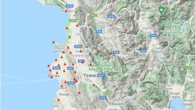AlbACa – 2019 M6.4 Albanian Earthquake Aftershock Campaign
On 26th of November 2019 an Mw 6.4 earthquake ruptured near the port town of Durres, only 25 km from Tirana, the capital of Albania. The earthquake caused major damage and killed 51 people, making it the deadliest earthquake in 2019 worldwide. The mainshock was relatively deep (~25 km) and of thrust type. In December 2019, a Hazard and Risk team (HART) from German Center for Geosciences (GFZ), Karslruhe Institute of Technology (KIT) in cooperation with the Institute of Geosciences, Energy, Water and Environment (IGEWE) of the Polytechnic University of Tirana, Albania installed a 30-station seismic network in the epicentral region to record aftershocks. Stations were equipped with short-period (1 Hz or 4.5 Hz) 3-component seismometers and CUBE data loggers recording continuously 100 sps.
We use these data to resolve the fine-scale structure of the responsible faults and to image the source region using tomographic methods.
Publications:
Schurr, B., Dushi, E., Rietbrock, A., Duni, L. (2020): AlbACa – Albanian Earthquake Aftershock Campaign. doi.org/10.14470/4X7564679396
Woollam, J., van der Heiden, V., Rietbrock, A., Schurr, B., Tilmann, F., & Dushi, E. (2022). Machine learning event detection workflows in practice: A case study from the 2019 Durrës aftershock sequence. In arXiv e-prints (p. arXiv:2205.12033).

